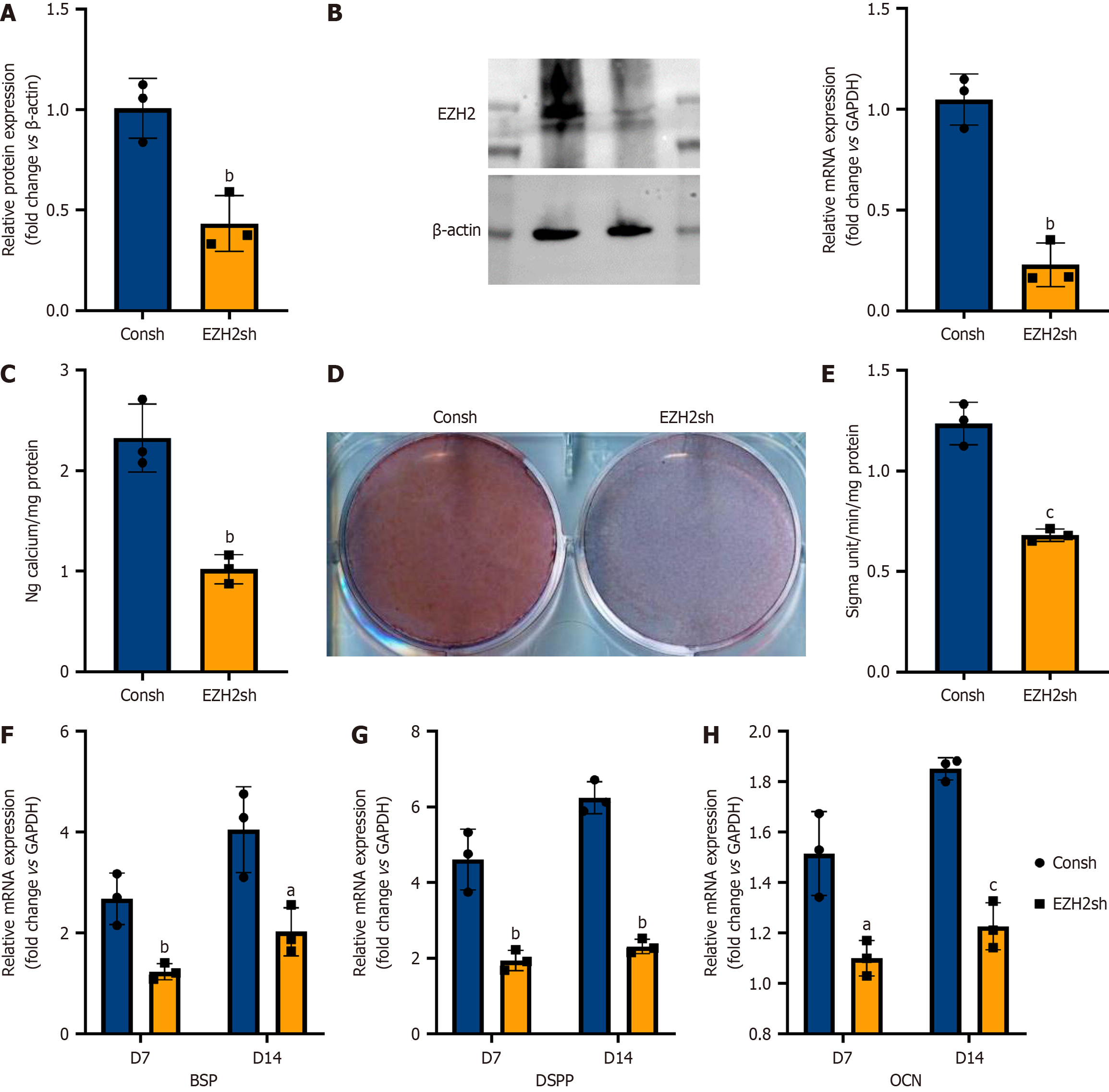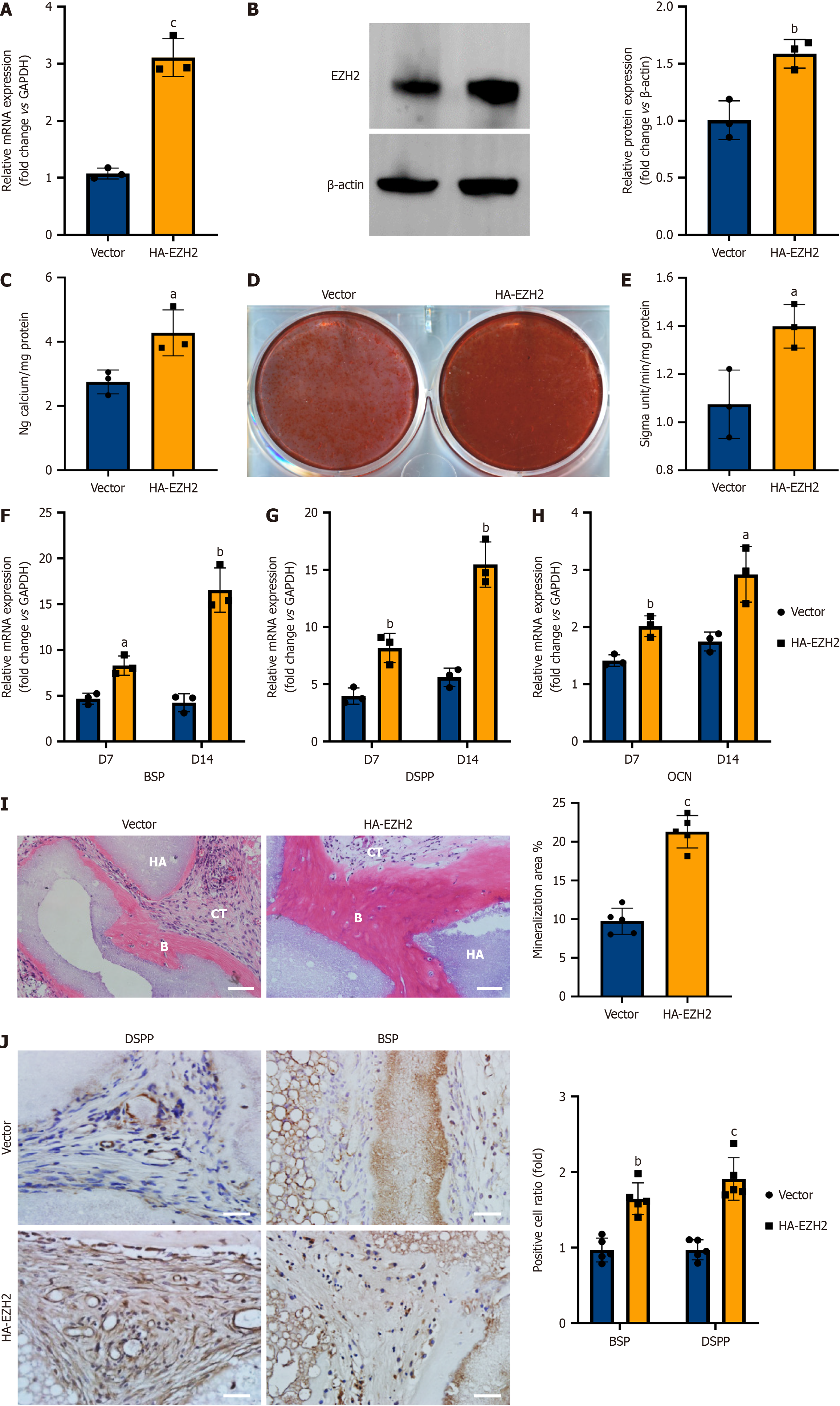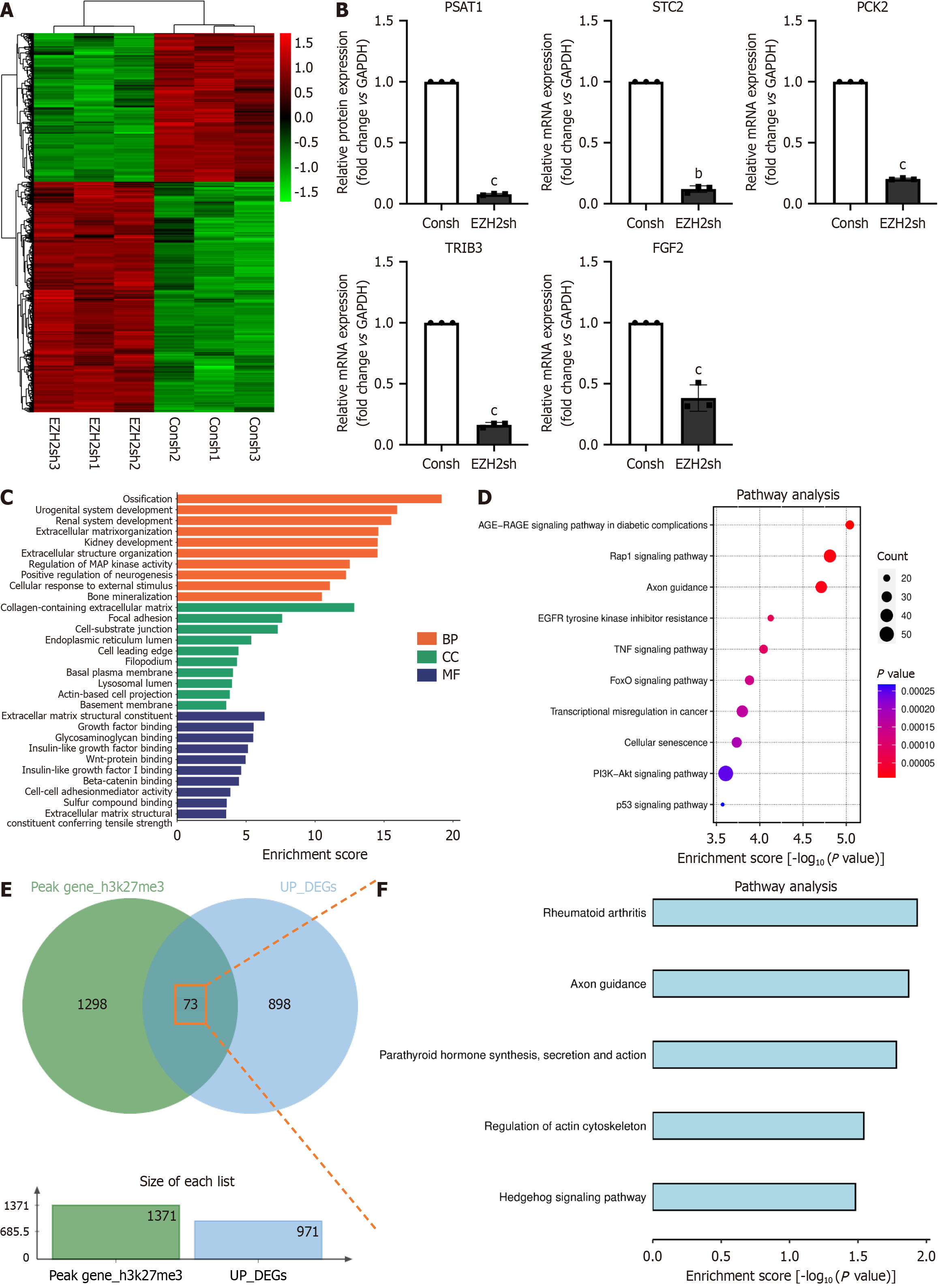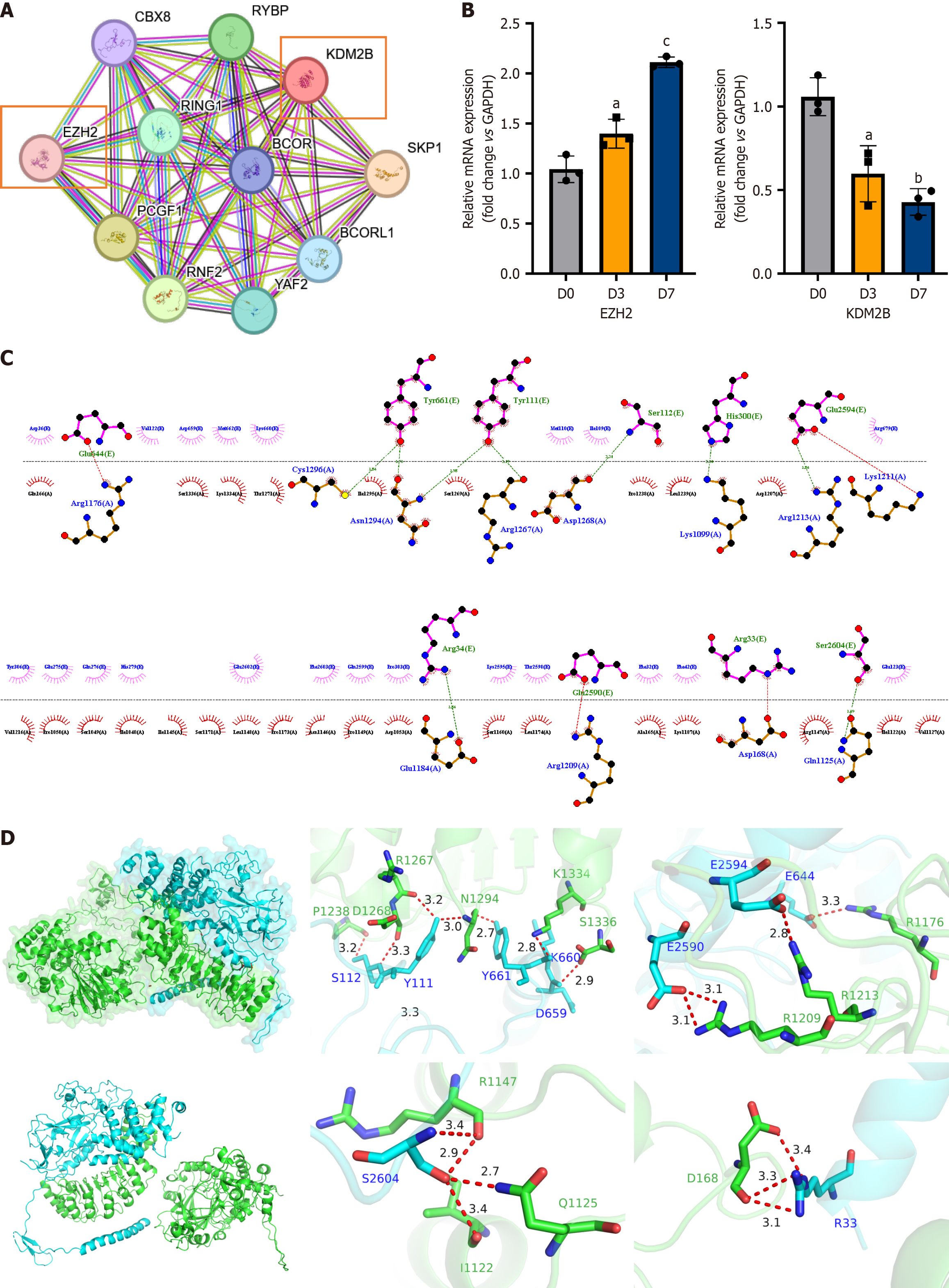Copyright
©The Author(s) 2025.
World J Stem Cells. Apr 26, 2025; 17(4): 103482
Published online Apr 26, 2025. doi: 10.4252/wjsc.v17.i4.103482
Published online Apr 26, 2025. doi: 10.4252/wjsc.v17.i4.103482
Figure 1 Knockdown of enhancer of zeste homolog 2 inhibits steo/dentinogenic differentiation potential of human apical papillary stem cells.
A: Quantitative polymerase chain reaction showed that the expression of enhancer of zeste homolog 2 (EZH2) was inhibited in human apical papillary stem cells (hSCAPs); B: Western blot analysis confirmed the knockdown of EZH2 in hSCAPs; C: Knockdown of EZH2 decreased alkaline phosphatase activity in hSCAPs; D and E: Alizarin red staining and quantitative calcium analysis demonstrated that knockdown of EZH2 inhibited mineralization in hSCAPs; F-H: Quantitative polymerase chain reaction showed that knockdown of EZH2 downregulated mRNA expression levels of bone sialoprotein (F), dentin sialophosphoprotein (G), and osteocalcin (H) in hSCAPs. GAPDH and ACTB was used as the internal controls. Data are presented as the mean ± SD (n = 3). Statistical analysis was performed using Student’s t-test. aP ≤ 0.05, bP ≤ 0.01, cP ≤ 0.001. EZH2: Enhancer of zeste homolog 2; BSP: Bone sialoprotein; DSPP: Dentin sialophosphoprotein; OCN: Osteocalcin.
Figure 2 Overexpression of enhancer of zeste homolog 2 enhances osteo/dentinogenic differentiation potential of human apical papillary stem cells.
A: Quantitative polymerase chain reaction showed that enhancer of zeste homolog 2 (EZH2) was overexpressed in human apical papillary stem cells (hSCAPs); B: Western blot analysis confirmed overexpression of EZH2 in hSCAPs; C: Overexpression of EZH2 increased alkaline phosphatase activity in hSCAPs; D and E: Alizarin red staining and quantitative calcium analysis results demonstrated that overexpression of EZH2 enhanced mineralization in hSCAPs; F-H: Quantitative polymerase chain reaction showed that overexpression of EZH2 upregulated mRNA expression levels of bone sialoprotein (F), dentin sialophosphoprotein (G), and osteocalcin (H) in hSCAPs; I: Hematoxylin-eosin staining and quantitative measurement showed that overexpression of EZH2 promoted bone/dentin-like tissue formation. Scale bar = 100 μm (B: Bone/dentin-like tissues; HA: Hydroxyapatite tricalcium carrier; CT: Connective tissue); J: Immunohistochemical staining and quantitative analysis of dentin sialophosphoprotein and bone sialoprotein. GAPDH and ACTB were used as the internal controls. Data are presented as the mean ± SD (n = 3). Statistical analysis was performed using Student’s t-test. aP ≤ 0.05, bP ≤ 0.01, cP ≤ 0.001. EZH2: Enhancer of zeste homolog 2; BSP: Bone sialoprotein; DSPP: Dentin sialophosphoprotein; OCN: Osteocalcin.
Figure 3 Enhancer of zeste homolog 2 inhibits expression of osteogenic differentiation-related genes independently of histone methyltransferase effect.
A: Heatmap illustrating differential gene expression in human apical papillary stem cells (SCAPs) following enhancer of zeste homolog 2 (EZH2) knockdown; B: Quantitative polymerase chain reaction analysis validated the expression changes of five randomly selected genes, consistent with the findings of the mRNA transcriptome microarray analysis; C: Histogram presenting significant results of Gene Ontology analysis for differentially expressed genes in SCAPs with EZH2 knockdown compared to the control group; D: Scatter plot depicting Kyoto Encyclopedia of Genes and Genomes pathway enrichment statistics for differentially expressed genes in SCAPs with EZH2 knockdown compared to the control group; E: Venn diagram showing the intersection between genes upregulated in human apical papillary stem cells following EZH2 knockdown and those associated with reduced trimethylation levels at the H3K27 locus; F: Histogram displaying significant Gene Ontology analysis results for differentially expressed genes in SCAPs with EZH2 knockdown relative to the control group. Data are presented as the mean ± SD (n = 3). Statistical analysis was performed using Student’s t-test. bP ≤ 0.01, cP ≤ 0.001. PSAT1: Phosphoserine aminotransferase 1; STC2: Stanniocalcin 2; PCK2: Phosphoenolpyruvate carboxykinase 2; TRIB3: Tribbles pseudokinase 3; FGF2: Fibroblast growth factor 2; EZH2: Enhancer of zeste homolog 2.
Figure 4 Reduction of enhancer of zeste homolog 2 binding to lysine demethylase 2B promotes osteogenic differentiation of human apical papillary stem cells.
A: The protein-protein interaction network analysis revealed potential direct or indirect interactions between enhancer of zeste homolog 2 (EZH2) and lysine demethylase 2B (KDM2B); B: Quantitative polymerase chain reaction confirmed that EZH2 expression progressively increased, while KDM2B expression gradually decreased during the induction of osteogenic differentiation in human apical papillary stem cells; C and D: Molecular docking simulations predicted the binding modes and affinities between EZH2 and KDM2B proteins. C illustrates the two-dimensional interactions, while D presents the three-dimensional binding conformations. Data are presented as the mean ± SD (n = 3). Statistical analysis was performed using Student’s t-test. aP ≤ 0.05, bP ≤ 0.01, cP ≤ 0.001. EZH2: Enhancer of zeste homolog 2; KDM2B: Lysine demethylase 2B.
Figure 5 Enhancer of zeste homolog 2 bioactive peptides effectively block lysine demethylase 2B binding to enhancer of zeste homolog 2 and promote human apical papillary stem cell osteogenic differentiation.
A and B: Peptide site immunohybridization results confirmed the presence of a direct binding site between enhancer of zeste homolog 2 (EZH2) and lysine demethylase 2B; C: Gray value analysis identified 16 positive loci, with gray values ranging between 80%-100%; D: Schematic illustration of different functional domains of EZH2 protein; E: Co-immunoprecipitation assays indicated that peptides PP7 and PP8 effectively inhibited interaction between EZH2 and lysine demethylase 2B; F: Alkaline phosphatase staining demonstrated that EZH2 peptides significantly promoted osteogenic differentiation of apical papillary stem cells. Data are presented as the mean ± SD (n = 3). Statistical analysis was performed using Student’s t-test. aP ≤ 0.05. EZH2: Enhancer of zeste homolog 2; KDM2B: Lysine demethylase 2B; ALP: Alkaline phosphatase.
- Citation: Xu HY, Wang YT, Yang HQ, Cao YY, Fan ZP. EZH2, via an association with KDM2B, modulates osteogenic differentiation of root apical papillary stem cells. World J Stem Cells 2025; 17(4): 103482
- URL: https://www.wjgnet.com/1948-0210/full/v17/i4/103482.htm
- DOI: https://dx.doi.org/10.4252/wjsc.v17.i4.103482

















